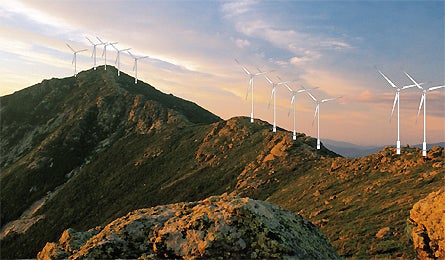Wind Power: Turbulence Ahead

'An artist's take on wind turbines atop New Hampshire's Franconia Ridge.'
Imagine 30 wind turbines whirring ATOP two remote Maine peaks. The 300-ton towers, with blades sweeping 400 feet high and aglow with aircraft-warning lights, would each produce 9,000 megawatt-hours of renewable electricity per year. So what’s wrong with this picture? A lot, according to groups like the Appalachian Mountain Club (AMC) and the Appalachian Trail Conservancy (ATC)–like the fact that the windmills in this proposed farm would be visible from a 34-mile stretch of the Appalachian Trail.
When a developer tried to make this project a reality on Redington and Black Nubble Mountains in 2006, outdoor advocates balked, envisioning the area’s pristine mountaintop panoramas and sensitive slopes ruined by the construction of enormous turbines. Maine’s Land Use Regulatory Commission agreed, rejecting the full project in 2007 and nixing a scaled-back version early this year. But it greenlighted several other wind farm proposals, including a 44-turbine operation on nearby Kibby Mountain. Fans of wind bemoaned this mixed record, arguing that clean energy was worth the sacrifice.
Wind farms represent hard tradeoffs for hikers, birdwatchers, and other nature lovers, especially in Eastern states, where consistent and strong gusts tend to blow across scenic ridges. The AMC, ATC, and groups such as Maine Audubon stress that they don’t oppose wind power everywhere–and insist that they understand how seriously air pollution and climate change threaten wild places. But they also argue that wind farms put more at stake than the view: Mountaintop development requires clearing land and building access roads, which could harm wildlife and damage fragile ecosystems.
Despite these controversies, wind energy is one of the world’s fastest-growing renewable power sources. With good reason: At optimum sites, it’s economically competitive with fossil fuels and doesn’t emit pollutants that contribute to acid rain, smog, or climate change. It’s also plentiful, as any Mt. Washington hiker can attest. “Wind has to play a significant role if we’re going to address our environmental concerns,” says Jeff Deyette, an energy analyst with the Union of Concerned Scientists. “That will require responsible development in places where hikers like to go.”
But increasingly powerful turbines mean wind farms are becoming more intrusive in wild settings. PPM Energy wants to expand a Searsburg, Vermont, farm by adding 17 new 400-foot towers–some on land in Green Mountain National Forest. “Wind development is industrial development, especially when you put a lot of turbines in one area,” says ATC Conservation Director Laura Belleville. “We wouldn’t oppose a project just because it affected views, but we need to think very critically about its short- and long-term impacts.” (The ATC is neutral on the Searsburg proposal.)
In the absence of federal regulations for siting wind farms, the AMC and ATC are stepping in to help steer the process. Both use GIS data to rank potential development areas based on the presence of resources like rare plants, wildlife habitat, trails, and views from the AT and the Long Trail. The AMC has already endorsed several projects in Maine, and the ATC is open to supporting farms that meet its criteria. “It’s much more appropriate to put a site where you can already see other human uses, like roads and towns,” says AMC scientist Dave Publicover.
“Air pollution and climate change have very significant impacts on the places we care about, so we’re not going to put our heads in the sand and say that someone else should solve the problem,” Publicover says. “If we’re going to find a solution, everybody will have to accept some changes.” For hikers, that could soon mean turbine blades spinning on the horizon.